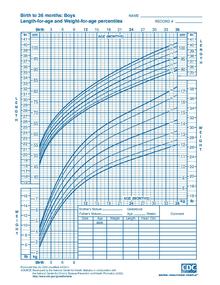
Back فشل النمو Arabic Zastoj u rastu BS Manglende trivsel Danish Gedeihstörung German اختلال رشد کودک Persian Retard de croissance staturo-pondérale French 成長障害 Japanese ภาวะเลี้ยงไม่โต Thai
| Failure to thrive | |
|---|---|
| Other names | Faltering weight, weight faltering[1] |
 | |
| Standard growth chart for boys age 0-36 months | |
| Specialty | Pediatrics |
Failure to thrive (FTT), also known as weight faltering or faltering growth, indicates insufficient weight gain or absence of appropriate physical growth in children.[2][3] FTT is usually defined in terms of weight, and can be evaluated either by a low weight for the child's age, or by a low rate of increase in the weight.[4]
The term failure to thrive has been used in different ways,[5] as there is no single objective standard or universally accepted definition for when to diagnose FTT.[6][7] One definition describes FTT as a fall in one or more weight centile spaces on a World Health Organization (WHO) growth chart depending on birth weight or when weight is below the 2nd percentile of weight for age irrespective of birth weight.[8][9] Another definition of FTT is a weight for age that is consistently below the 5th percentile or weight for age that falls by at least two major percentile lines on a growth chart.[10] While weight loss after birth is normal and most babies return to their birth weight by three weeks of age, clinical assessment for FTT is recommended for babies who lose more than 10% of their birth weight or do not return to their birth weight after three weeks.[8] Failure to thrive is not a specific disease, but a sign of inadequate weight gain.[11]
In veterinary medicine, FTT is also referred to as ill-thrift.
- ^ Shields B, Wacogne I, Wright CM (September 2012). "Weight faltering and failure to thrive in infancy and early childhood" (PDF). BMJ. 345 (sep25 1): e5931. doi:10.1136/bmj.e5931. PMID 23014901. S2CID 1339246.
- ^ Goh, Lay Hoon; How, Choon How; Ng, Kar Hui (June 2016). "Failure to thrive in babies and toddlers". Singapore Medical Journal. 57 (6): 287–291. doi:10.11622/smedj.2016102. ISSN 0037-5675. PMC 4971446. PMID 27353148.
- ^ Homan, Gretchen J. (2016-08-15). "Failure to Thrive: A Practical Guide". American Family Physician. 94 (4): 295–299. ISSN 0002-838X. PMID 27548594.
- ^ "Failure to Thrive: Miscellaneous Disorders in Infants and Children: Merck Manual Professional". Archived from the original on 2012-11-29. Retrieved 2010-03-23.
- ^ Hughes I (February 2007). "Confusing terminology attempts to define the undefinable". Archives of Disease in Childhood. 92 (2): 97–98. doi:10.1136/adc.2006.108423. PMC 2083328. PMID 17264278.
- ^ Raynor P, Rudolf MC (May 2000). "Anthropometric indices of failure to thrive". Archives of Disease in Childhood. 82 (5): 364–365. doi:10.1136/adc.82.5.364. PMC 1718329. PMID 10799424.
- ^ Olsen EM, Petersen J, Skovgaard AM, Weile B, Jørgensen T, Wright CM (February 2007). "Failure to thrive: the prevalence and concurrence of anthropometric criteria in a general infant population". Archives of Disease in Childhood. 92 (2): 109–114. doi:10.1136/adc.2005.080333. PMC 2083342. PMID 16531456.
- ^ a b National Guideline Alliance (UK) (2017). Faltering Growth – recognition and management. National Institute for Health and Care Excellence: Clinical Guidelines. London: National Institute for Health and Care Excellence (UK). ISBN 978-1-4731-2693-0. PMID 28991420.
- ^ "Weight-for-age Child growth standards". World Health Organization. Retrieved 2017-11-15.
- ^ Cole, Sarah Z.; Lanham, Jason S. (2011-04-01). "Failure to Thrive: An Update". American Family Physician. 83 (7): 829–834. ISSN 0002-838X. PMID 21524049.
- ^ Homan, Gretchen J. (2016-08-15). "Failure to Thrive: A Practical Guide". American Family Physician. 94 (4): 295–299. PMID 27548594.
© MMXXIII Rich X Search. We shall prevail. All rights reserved. Rich X Search